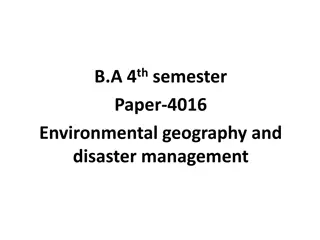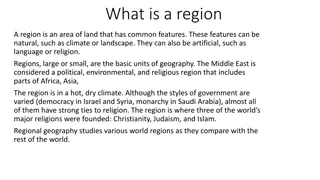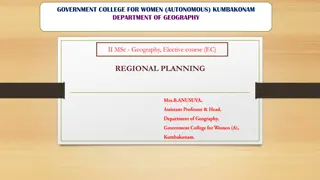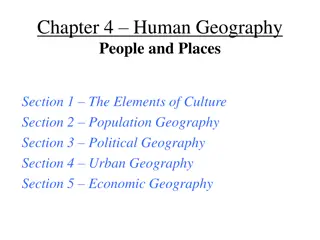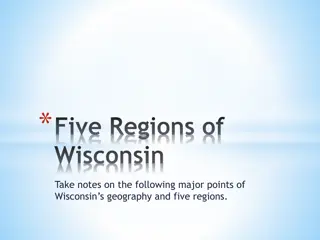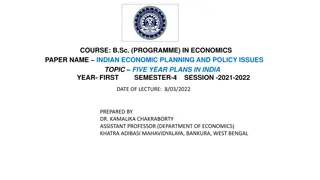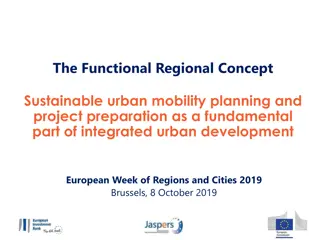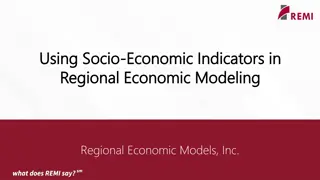Understanding Regional Planning and Economic Regions in Geography
Regional planning involves defining regional units, planning regions, and economic regions to ensure sustainable development. It focuses on creating suitable areas for population and employment distribution. The characteristics of planning regions include resource homogeneity, internal coherence, and operational features. Economic regions in India are determined based on geographical, social, and economic factors to promote development and data analysis.
Download Presentation

Please find below an Image/Link to download the presentation.
The content on the website is provided AS IS for your information and personal use only. It may not be sold, licensed, or shared on other websites without obtaining consent from the author. Download presentation by click this link. If you encounter any issues during the download, it is possible that the publisher has removed the file from their server.
E N D
Presentation Transcript
GOVERNMENT COLLEGE FOR WOMEN (AUTONOMOUS) KUMBAKONAM DEPARTMENT OF GEOGRAPHY II M.Sc - Geography, Elective course (EC) REGIONAL PLANNING
REGIONAL UNITS DEFINITION: Regional units means the subdivisions of the Country's region, are fruther subdivided into municipalities. A single thing, or group forming part of a whole. Unit is the standared assigned to measure physical quantity. Types of Units: 1) Fundamental units. 2) Derived units. 1)The physical quantities are called fundamental units. It's a independent or can not derive from any other units is called Fundamental units. 2) derived means it dependent for any other units...like Man-made features.
PLANNING REGIONS KEEBLE defined a planning region is to be an area that is large enough to sustainable changes in the distribution of population and employment to take place within it's boundary. The regions for planning purposes may be administrative or political regions such as State, Disrtict or the Block. The Planning region should have the following characters are a) It should be large enough to contain a range of resources. b) It's resource position is such that a satisfactory level of product contribution are consumption and for exchange would be feesable.
PLANNING REGIONS - Charactres: c) The intrenal homogenity of resources structure should logically link up the anticipated future so, as to make future relavent to the present. d) The region should be internally cohensive area. e) That Planning region is essentially opreational in character. Therefore a high degree of flexcibility and elastically should be maintained in the process of regional demarcation.
The best definition of a planning region emphasizinh the factors of Homogenity, Nodality and Administrative convenience. Geographically it should be sub-divided into plain, hilly, track, coastal belt,lake area. The people of the region should have social and culural cohensiveness. The region should be a separat unit for data collection and analysis. The region should have an economic existence which can be assessed from statistical records.
It should be small enough to ensure local people's participatin in it's development. It should be under one administrative agency. It should not be too small. It's geograpphical size should be big enough to exploit resoureces and avoid partial utilization. It should have fairy homogenious economic strucure. It should have one or more growth points.
ECONOMIC REGIONS OF INDIA The knowledge of the natural region is essential for undertaking the basic Geography of the country. It is not much use as for as economic planning is concerned. It's static and merely describes the existing situvation, while for proposed of planning it is necessary to study the natural resources of region in detail and also to findout areas of potetial development and to trace interlinkages among them. Dependimg upon the physical, geographical and economic features and the socio-cultural factors. The Economic Regions are... Many authuors have attempted to devide India into economic regions. BHAT and RAO, identified 11 major regions and 51 sub-regions. The regional development, it is common for the major region as a whole, sub divisions are identified dependng upon the concentration of resuorces, problems for development and administrative convenience.
The major 11 regions: The major 11 regions: 1 1. . Western Coastal region. Western Coastal region. 7. The Gangetic Plain 7. The Gangetic Plain 2. Western Ghats 2. Western Ghats 8. Assam 8. Assam 3. Central Plateau 3. Central Plateau 9. Gujarat 9. Gujarat 4. Eastern Ghats 4. Eastern Ghats 10. Rajastan and 10. Rajastan and 5. East Coast 5. East Coast 11. Kasmir and the Northern Hilly Valley. 11. Kasmir and the Northern Hilly Valley. 6. North Eastern Plateau 6. North Eastern Plateau
Besides these major regions are classified 51 sub-regions were identified. Regions based on power-mettal rgioal base as strong catylusts for attaining balance of regional development is necessary. In this way macro economic regions can be defined by grouping parts of different states. MACRO REGIONS GROUPS OF STATES ORPARTS OF COMPRISING REGION. 1. South India - Karnataka, Kerala, Tamilnadu, Andhra Pradesh, Parts of Maharastra, Madhya Pradesh and Orissa. 2. Western India - Most of the Parts of Maharastra and Gujarat. 3. Eastern Central India - Parts of Tamilnadu, Orissa, Maharastra and Andhra Pradesh.
4. North Eastern India - Bihar, West Bengal, Parts of Orissa and Assam. 5. The Middle Gangetic Plain - Uttar Pardesh (Except Hilly districts). 6. North Western India - Rajasthan Parts of Punjab nd Haryana. 7. Northern India - Including Parts of Punjab, Haryana, Himachal Pradesh and Jammu & Kashmir. There is a lack of Inter -Regional data, But suggests that it's better to define Macro Economic Megions comprising groups of states rather than their parts. These Macro-Regions are 5 and include the states mentioned below.
MACRO REGIONS - GROPS OF COMPRISING STATES 1. Southern Region - Kerala, Tamilnadu, Andhra Pradesh. 2. Western Region - Maharastra, Gujarat. 3. Eastern Region - Bihar, Orissa, West Bengal, amd Assam. 4. Northern Region - Punjab, Haryana, Rajasthan and Jammu & Kashmir. 5. North Central - Uttar Pradesh, Madhya Predesh. PLANNING REGIONS Significance of Demarcation of Planning Regions: There is increasing disparities and imbalances in economic development in india. The objective of regional planning is a balanced economic Developments. C.S.CHANDRASEKARA Delinated various palnninh regions of India. It's based on minimum resource potentials of different regions.
Rich areas linked with poor areas. so, that benefits of activities of rich region may flow into poor areas. Planning regions should have 3 primary requirements for generating economic activities. 1. Land 2. Rew Materials for Industrial development. and 3. Power. These 3 principle factors will enable each planning region to active a degree of self-sufficiency in flood , an employment potential in the Agricultural and Non-Agricultural sectors. These Planning regions should have the basic elements to acieve as dergee of economic viability.
The Scheme submitted to the Town and Country Planning organization, there ara 13 Macro- regions . These macro regions further are sub-divided into 35 Meso Regions. 2. Central Peninisular 3. Western Peninisular 4. 8. Aravalli Region 9. Jammu & Kashmirand Ladakh. 10. Irons - Indo Gangetic Plains & Hills. 11. Ganga Yamuna Plains. 12. Lower Ganga Plains, and 13. North Eastern Regions. a 10. stern Peninsul9.arnvv 6. Gujarat 7. Westrrn Rajasthan 8. Aravalli Region sular 4. Central Deccan South peninisular 2. Cennnnnnntral Peninisular 3. Western PeniniSouth peninisular The Macro Regions are: 1.South peninisular 2. Central Peninisular 3. Western Peninisular 4. Central Deccan 5. astern Peninsular 6. Gujarat 7. Westrrn Rajasthan
The scheme of Planning regions cut areas state and district boundaries. Further CHANDRA SAKHARA said that there would not be conflict between the boundaries of Planning Region an Administrative Rgions. The state boundaries should Coinside with the planning regions boundaries. Then only we can easilyimplement the policies and programme for the Regional development. STATE AS REGIONS: The formulation of linguistic state has been a matter of Great political importance after Independence. The Bifurcation has been promoted the economic consolidation of these,areas and has strenghtened the intra stste production - economic links and integration of their economy.
There are 30 States and 7 Union Territories in India. Such as: (Include Our States Names and Union Territories) Union Territorie: 1. Delhi 2. Andhaman & Nichobar 3. Diu -Dauman. 4. Lakshaweep 5. Pondicerry 6. Dadra Nagar Havihi 7. Chandigarh.




